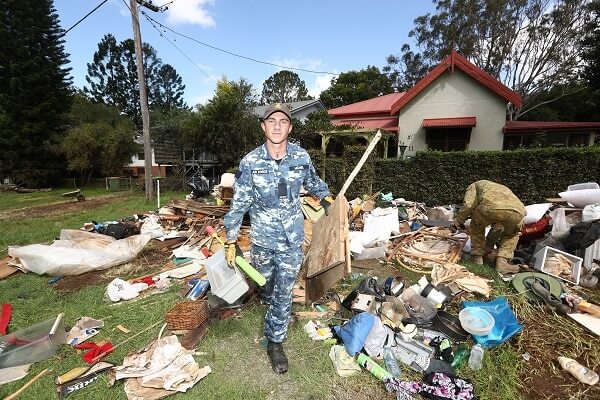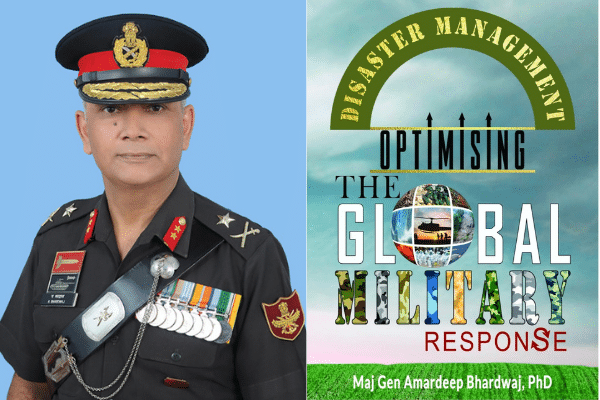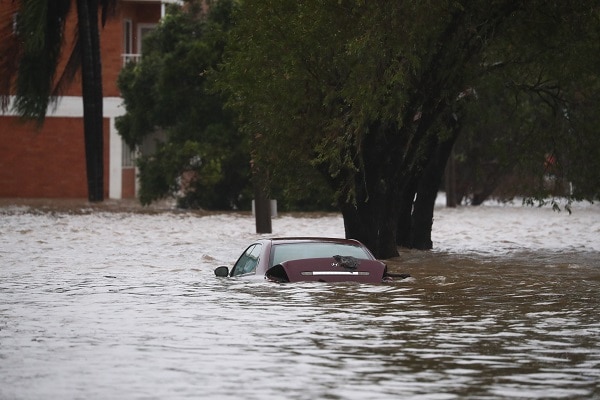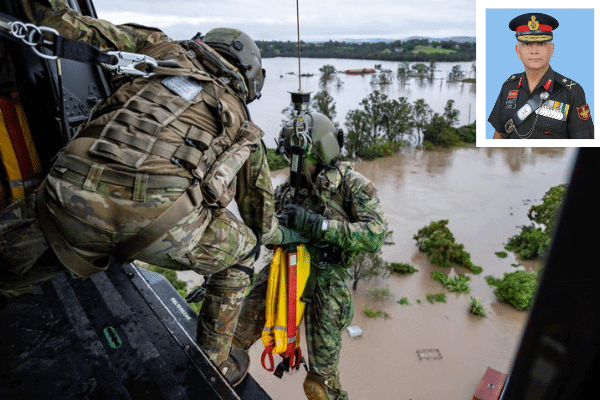The Australian Defence Force has had a busy few years on the home front, stepping in to assist after the Black Summer bushfires, helping with pandemic relief efforts, and more recently, helping in the clean-up after floods devastated parts of Australia’s east coast in the last two months.
Still, concerns continue to be raised as to the timeliness and effectiveness of the response in coordination with other agencies in the event of disasters. In early March, NSW Premier Dominic Perrotett conceded that the emergency flood response had not been good enough after hundreds of people were left without food, water, and fuel, and many were stranded on rooftops awaiting evacuation. By 14 March, the NSW State Emergency Service (SES) commissioner was forced to comment on a controversial decision to reject ADF aid on two separate occasions, days before the deadly flooding began.
There are now more than 3,000 ADF personnel and assets on-ground in northern NSW to assist with flood relief, as of 30 March.
It’s evident that governments call on the military to help with crises, but as many have been recently wondering, how optimal is the response? A new book by a Sydney-based retired Indian Army General aims to tackle these questions head-on.
Major General Amardeep Bhardwaj, PhD (Retd) explained: “Throughout history, militaries around the world have been at the forefront in responding to disasters; saving lives, bringing succour and dispensing aid. The Military is a country’s biggest resource, with better logistics, manpower, and guts than any other agency, to tackle disasters. Considering that most militaries are often not engaged in warfighting, there is vast scope for them to play a bigger, more meaningful, role in disaster response.”
Many Indians are familiar with the military’s long history of providing aid in the time of crises, outlined in the Disaster Management Act passed in 2005. Here in Australia, though, it isn’t quite as straightforward. ADF involvement in disaster response can be traced back as far as the Hobart Fires in 1967, but as the Royal Commission into National Natural Disaster Arrangements recently noted after the 2019-2020 bushfires, there’s a lack of understanding about the role, capacity, and capability of the ADF in relation to natural disasters.

In the last few weeks, many of us have seen images of flood-relief efforts on the ground, including ADF personnel clearing belongings from waterlogged homes. The author points out that instances like this, when given adequate coverage in the media, catch the people’s attention, raising pertinent questions about the efficiency and timeliness of the disaster response.
“When I saw the graphics of soldiers in Lismore, helping to carry items like clothes and mattresses out of houses, I couldn’t help but wonder if this was the best way to employ the military,” he said. “That is why I favour a ‘competency-based approach’ in assigning tasks to various agencies, including the military, in disaster operations. My book posits proper role definition, task assignment, training, equipping and organising a military – and this applies to all militaries in the world – for more efficient disaster response.”
In Disaster Management: Optimising The Global Military Response, published by Partridge Publishers, a Penguin-Random House Company, readers can expect to find various chapters focussing on one major aspect of the military’s role in Disaster Management. A review of the latest disaster trends, how to leverage technology, and wisdom drawn from the United Nations as well as other countries, add completeness and flavour to the book.
“There’s need for a systemic review and, if needed, an overhaul rather than knee-jerk reactions during crises,” elaborates General Amardeep. “The hidden truth is that militaries are not optimally trained, equipped, organised or mandated to undertake such specialised humanitarian tasks. They are, in fact, optimised for combat. But when not engaged in their primary role of war-fighting, there is tremendous scope for them to accrue much higher ‘peace-dividends’ in serving humanity.”
READ ALSO: On Chint Singh, a World War II POW rescued by the Australian Army
A career in the military
The book combines Major General Bhardwaj’s 40 years of professional experience in the military, including disaster/ emergency operations, their planning, policymaking and advocacy, and over a decade of focused research in the field.
His career in the military began immediately as a 17-year-old when he joined training at the National Defence Academy (NDA) in Pune for three years, followed by a year at the Indian Military Academy (IMA) in Dehradun.
“Early in my career, I was placed in an Emergency Management Committee,” he recalled. “When I inquired about what that meant, I was told that it’s a pre-constituted team in the army to be ready and provide assistance towards disasters and emergencies.”
Fast forward a few years and he found himself among an emergency response team flying MI-17 helicopters into fierce weather conditions in the Himalayan heights of Himachal Pradesh, where in July 2000, locals described “a 100-feet high wall of water” blasting through the Baspa River Valley at midnight, destroying everything in its path, especially the villages around Karcham.
“I still remember the terrible weather and how it was dangerous for any aircraft, even army helicopters, to be flying in. No one in their right mind would go into that storm, but we did,” he said. “At the time, I’d turned to my superior and asked, ‘how long will we need to be here?’ He told me, without a moment’s hesitation, ‘as long as it takes.’”

Over the years, he played a role in various disaster responses by the Indian Military, being involved in field operations as well as their management at higher headquarters. He still recalls his experience with man-made disasters, having served as a United Nations Peacekeeper in Angola in 1997.
“AIDS and other diseases were rampant while the warring factions fought ceaselessly with military weapons and laid extensive mines. Life expectancies were short, it was hard to find a local who could survive till 60 and have grey hair! It was a solemn reminder of how disasters, man-made or natural, can be devastating,” he shared with Indian Link.
After this experience, he decided to supplement his practical knowledge from the field with a certificate in disaster management, becoming perhaps one of the first Indian military officers to do so.
In 2012, Major General Bhardwaj successfully defended his thesis on “Role of the Indian Military in Disaster Management” to earn his PhD in Defence Studies (specialising in Disaster Management) from Chaudhary Charan Singh University, Meerut. His supervisor was Dr Harvir Sharma, an esteemed Indian scholar and perhaps the only D.Litt in the field.
“After my PhD, I began to wonder – what is the case with other countries? I then started studying how the militaries of China, the United States, Australia, Japan and many others engaged in disaster response; also how various organs of the United Nations and some of the global NGOs participated in disaster management. Two realisations dawned; firstly, it seemed there were identical problems in almost all militaries, and secondly, couldn’t the solutions be the same or at least similar?”
Inspired to look into the issue on a global scale, his book Disaster Management: Optimising The Global Military Response was born.
“This book is especially relevant to the military, para-military, civil-defence, police, and other emergency services, irrespective of country or nationality. It offers valuable insights for policy-makers, practitioners, students and stakeholders in the field of Disaster Management, all around the world,” Major General Bhardwaj noted. (He adds that he has reached out to the offices of the Australian Federal Ministers for Defence as well as Emergency Management, National Recovery and Resilience to contribute his insights but has not received any response from them).
READ ALSO: Kids commemorating Anzac Day 2021

Advocating for climate action and sustainability
As the Federal Elections draw near, he’s got a crucial message for voters in Australia.
“The Australian voter deserves to be told exactly where a political party stands on vital issues concerning disasters, including climate change, deforestation, pollution, bio-fuels and sustainable development. Sometimes, one gets to hear some broad-brush remarks about an odd issue here and there but that’s no good; the voter needs clarity on action plans, time-lines, budgetary support and measurable outcomes. The devil lies in the detail, but that is what helps the voter to decide who to vote for.”
“We’ve tinkered with mother nature a bit too much and now all of mankind’s resources are falling woefully short. There’s an ever-widening capability gap,” the General points out.
“Disaster trends are unambiguous that in future the frequency and ferocity of disasters will increase manifold. But governments around the world are going about business as usual. Mankind’s capabilities to cope with this growing threat need urgent and exponential upscaling. It is here that the idea to assign a bigger role to the world’s militaries, in disaster response, can be a life-saver for planet earth.”
As a scholar in disaster management, he’s well-versed in the ways that man’s actions, no matter how harmless, can go on to affect our natural surroundings.
“Ancient cultures of the world, including in India and Australia, have fantastic wisdom about the right way to interact with and respect nature. I believe it’s important to preserve this knowledge. One of the ways to go forward is, in fact to go backward to preserve and utilise this ancient wisdom,” states General Bhardwaj.




